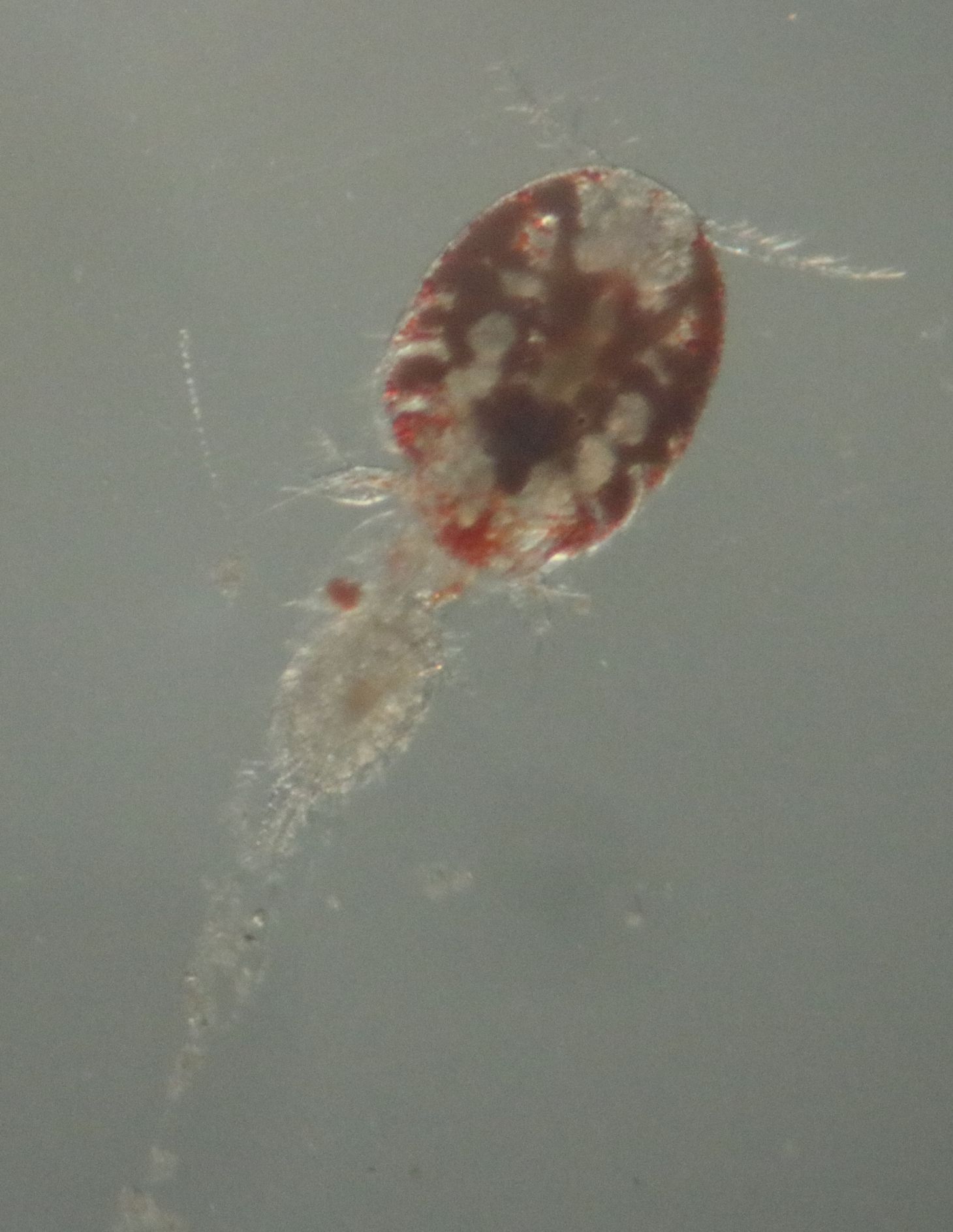Clausidium vancouverensis (Haddon, 1912)Common name(s): Red copepod |
|
| Synonyms: Clausidium californiense, Clausidium vancouverense, Hersilia vancouverensis |  |
|
Phylum Arthropoda
Subphylum Crustacea
(Group
Maxillipoda-invalid)
Class Copepoda
Subclass Neocopepoda
Superorder Podoplea
Order
Poecilostomatoida
Family Clausidiidae
|
|
| Clausidium vancouverensis copepod, apparently a female, from the gill chamber of the ghost shrimp Neotrypaea californiensis. Length around 1 mm. | |
| (Photo by: Dave Cowles, August 2020) | |
Description: Copepods are generally tiny crustaceans without a carapace but with a well-developed cephalic shield; a single, simple median eye, one or more of their six thoracic segments fused to their head and bearing maxillipeds, five abdominal segments (including telson) with generally no appendages, well-developed caudal rami, uniramous first antennae, and uniramous or biramous second antennae. They have many different lifestyles from pelagic to benthic and parasitic. Copepods from Order Poecilostomatoida are parasites on invertebrates and marine fishes and may have a reduced number of body segments.Specifically, they differ from other copopod Orders by having a slit-like mouth and sickle-shaped mandibles. Recent work suggests that Poecilostomatoida may simply be a specialized type of Cyclopoid copepod. Clausidium is a subtropical and temperate genus in most of the world's oceans that specializes in parasitizing mud shrimp and ghost shrimp. Some have suggested they might simply be a commensal instead of a true parasite. They typically grip firmly to their host but also readily move around the external surface and into the gill chambers. Males are much smaller than females and typically grasp her last abdominal segment. The first thoracic leg of the species is thick and has suckers which are used to adhere to the host for the female or to the female for the male. Sucker-like structures are also on legs 2-4. The last abdominal segment of the female has a modified structure which appears to facilitate attachment by the male.
How to Distinguish from Similar Species: Two other Poecilostomatoid copepods may also be found with Neotrypaea californiensis: Hemicyclops thysanotus and Goodingius (formerly Hemicyclops) subadhaerens. G. subadhaerens is reported from the burrows. H. thysanotus may also be found on the nudibranch H. crassicornis. I found no indication that either of these two other species is red. Carlton et al. plate 210 on p 469 has photographs of G. subadhaerens (identified as H. subadhaerens) and a female C. vancouverensis.
Geographical Range: Coastal Alaska to Baja California
Depth Range:
Habitat: On the bodies or in the gill chambers of Neotrypaea californiensis or Upogebia pugettensis or in their burrows.
Biology/Natural
History: As in
many copepods, females carry their eggs in special sacks attached to
their
first abdominal
somite. (segment) I found that these copepods were indeed very
tenacious
in their grip on their host but would periodically move around, and
that
occasionally one could be found attached to a surface near the host.
| Return to: | |||
| Main Page | Alphabetic Index | Systematic Index | Glossary |
References:
Dichotomous Keys:Kozloff, 1987, 1996 (as C. vancouverense)
General References:
Carlton
et al., 2007 (as C.
vancouverense)
Morris
et al., 1980 (as C.
vancouverense)
Scientific Articles:
Gooding, Richard U. (1963). External morphology and classification
of marine Poecilostome copepods belonging to the families Clausidiidae,
Clausiidae, Nereicolidae, Eunicicolidae, Synaptiphilidae, Catiniidae,
Anomopsyllidae,
and Echiurophilidae. Ph.D. Thesis, University of Washington, Seattle.
pp.
1-247.
Haddon, K., 1912. Hersilia (Clausidium) vancouverensis. Annals and
Magazine of Natural History (8)10:84-86
Light, S.F. and O. Hartman, 1937. A review of the genera Clausidium
Kossman and Hemicyclops
Boeck
(Copepoda, Cyclopoida) with the description of a new species from the
Northeast
Pacific. University of California Publications in Zoology 41(14):
173-188
Web sites:
General Notes and Observations: Locations, abundances, unusual behaviors:
Click here
to see a short video of Clausidium
vancouverensis inside the gill chamber of the ghost shrimp
Neotrypaea
californiensis collected in July 2020 from the beach at
Freeland, Whidbey
Island, WA. The beating scaphognathite
inside the gill chamber of the host and its disturbance of the nearby
copepods
can also be seen on the left.
Authors and Editors
of Page:
Dave Cowles (2020): Created original page
CSS coding for page developed by Jonathan Cowles
Salish Sea Invertebrates web site provided courtesy of Walla
Walla University